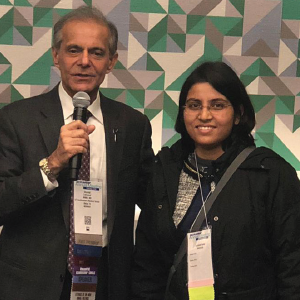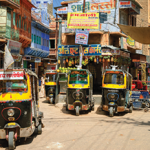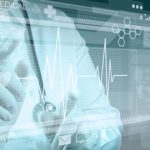
Dr. Dua (left), Dr. Ko (middle) and Dr. Sinha between clinics.
The ACR–Indian Rheumatology Association (IRA) International Fellows Exchange Program was developed in 2016 to foster scientific collaboration between members of the ACR and junior rheumatologists representing the IRA. I was lucky enough to be selected to participate in this exchange initiative, and I can’t thank these two organizations enough for working together to provide this amazing opportunity.
Background
I trained in rheumatology at the Institute of Post Graduate Medical Education and Research, Kolkata, India, for three years, from 2015 to 2018. I learned about this exchange program toward the end of my fellowship program from my mentor, Prof. Alakendu Ghosh, who on behalf of the IRA, encouraged me to submit my curriculum vitae.
Upon acceptance, I learned I would travel to Chicago for a month from September–October 2018 to do a rotation in the rheumatology section at the University of Chicago, and then attend and present an abstract at the 2018 ACR/ARHP Annual Meeting. I had never been to the U.S. before, and I quickly started preparing for my month abroad.
Experience in Chicago
As I pen my experience, I would like to begin by thanking my mentor, Anisha Dua, MD, MPH, for making me feel at home and ensuring I always felt like a part of the team. During my month exchange at the University of Chicago I spent time on the inpatient consult service, in the adult outpatient clinic and, because of my interest in juvenile arthritis, in the outpatient pediatric rheumatology clinic.
I was able to work with diverse attending physicians in the section and was impressed by the approach of the entire healthcare team toward patients and their families. I witnessed how the physicians would patiently listen to their patients’ concerns and how every aspect of diseases and management plans would be explained to the patients. I had the opportunity to discuss each patient with the faculty and fellows, and I learned a lot from these dialogues.
A unique aspect of the rheumatology experience at the University of Chicago was the subspecialty-focused clinics. I spent time focusing on vasculitis patients with Dr. Dua, on lupus patients with Kichul Ko, MD, and on myositis patients with James J. Curran, MD. These focused clinics gave me the opportunity to delve into nuances of specific disease states and management options.
Afternoon consultations were not only interesting, but also a bit of a challenge, having to deal with difficult cases referred from different departments.
I was surprised by the amount of severe sarcoidosis and complicated gout I encountered during the rotation. I had hands-on experience learning to use polarizing microscopy to look for crystals in synovial fluid, which was a new experience for me. On the whole, my academic experience was truly exciting.
Chicago is a beautiful city, with beautiful people. It is the only city in the U.S. that I have seen, so I have no point of comparison. I went almost everywhere possible in Chicago: the Art Institute, the Field and Science Museums, the Shedd Aquarium and Lincoln Park Zoo. The Architectural River Cruise was also exciting, although a little chilly. I was able to celebrate the Durga Puja, which is an important Bengali festival. I went to the Vedanta Vivekananda Society in Lemont, Ill. The Bengali students at the University of Chicago also arranged a Durga Puja celebration in the city, and I was able to attend that as well. I was happy to celebrate even though I was away from home.
New Perspectives

Dr. Dua (left) with Dr. Sinha at the IRA Reception during the 2018 ACR/ARHP Annual Meeting.
Through this exchange, I was able to perceive certain differences in the healthcare delivery systems between the two countries.
In India, the healthcare system varies from state to state and between the government and private sectors. I trained in a government, academic, tertiary care center.
We have rheumatology outpatient clinics on Monday, Wednesday and Friday, with an average of about 400 patients per day seen by 8–10 providers. On Tuesdays, we have lupus clinic, with about 100 to 150 patients per clinic. Our Indian lupus patients often have very aggressive disease with significant renal involvement. Two days a week, patients are seen by appointment. On the other three days, the clinic is open for all referred or follow-up rheumatology patients.
We also have a 30-bed inpatient rheumatology service, which is almost always fully occupied. Inpatient treatment is free for all. A fair proportion of patients are not well educated, making history taking and counseling far more difficult. Access to general medications is easy; in fact, we see many patients who land in our outpatient clinic after several years of over-the-counter self-medication with steroids, once prescribed by a local doctor.
The electronic medical record system in the U.S. is very advanced, and in our centers, especially with the high volume, it is difficult to maintain electronic records; rather, we rely on handwritten notes. Although this helps with patient flow, follow-ups and data retrieval can be difficult.
The high-volume exposure to patients and practical contact with diverse clinical scenarios helps us enrich our clinical skills. Additionally, during our training and in practice, we have hands-on experience in immunology labs and with musculoskeletal ultrasonography.
Unfortunately, research opportunities are less structured than what I observed in the U.S., with less training in methodologies and clinical study design.
Rheumatology is one of the most lucrative subspecialties at present in India. It is very competitive, with only 12–15 seats per year in the entire country. The fellowship, which we call DM [Doctor of Medicine program] in India, is three years and requires submission of an original work by the end of the tenure. We enter into practice after completing the board examination, which comprises both theory and practical portions.
2018 ACR/ARHP Annual Meeting

Dr. Sinha with Dr. Lakhanpal (left) at the IRA Reception during the 2018 ACR/ARHP Annual Meeting.
I culminated my time in Chicago at the 2018 ACR/ARHP Annual Meeting. This was my first time participating in this conference, and the level of intellectual exchange and collaboration was inspiring. I particularly enjoyed the concept of the fellows-in-training pre-conference session on the Friday before the full meeting began. It celebrated fellows working in the field of rheumatology from all around the world, and provided insights and interaction with peers, as well as leaders in the rheumatology world. It was a proud moment for me to be part of the program. It was also a great feeling to be honored by Sharad Lakhanpal, MBBS, MD, the 2017 ACR president, and David Daikh, MD, PhD, the 2018 ACR president, at the IRA Reception during the ACR/ARHP Annual Meeting.
Given my interest in pediatric rheumatology, I had submitted a poster on the assessment of treatment responses, with special reference to remission using juvenile arthritis disease activity scores (JADAS) in the different categories of juvenile idiopathic arthritis and was able to present my research to the ACR community at the international meeting. This gave me the opportunity to exchange ideas that will allow me to expand my project.
Getting to hear from the experts and learning about their perspectives on the way forward in immunology and rheumatology was enriching. The sheer volume of sessions and opportunities for learning was expansive, and I only wish I could have simultaneously attended many of the informative and innovative sessions.
Going Home
On a personal note, the faculty members and the fellows in the University of Chicago Department of Rheumatology were extremely friendly and supportive. They never let me feel the absence of my family over the month’s duration. Whenever I needed anything, the entire department was there, planning it out for me. As I come back to India, I bring with me a fulfilling experience that will help me be a better physician. But more so, I bring with me memories that will last a lifetime.
Debanjali Sinha, MD, is a rheumatologist in practice in Kolkata, India.
Acknowledgment
The author extends her thanks to Anisha B. Dua, MD, MPH, for her assistance, making her feel at home and more.



